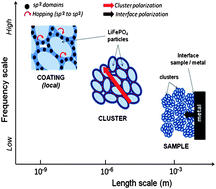Composite and nanostructured materials have hierarchical architecture with different levels: (a) macroscopic (substructure of porous clusters); (b) mesostructural (particles constituting the clusters); and (c) microscopic and nanometric (coatings, bulk of the particles). The identification of the key parameters that affect the electronic transport across all observed size scales is required, but is not possible using conventional dc-conductivity measurements. In this paper, the powerful broadband dielectric spectroscopy (BDS) from low-frequencies (few Hz) to microwaves (few GHz) is applied to one of the most important composite materials for lithium batteries. LiFePO4 is wrapped in a carbon coating whose electrical properties, although critical for battery performance, have never been measured due to its nanometre-size and the powdery nature of the material. We provide a description of the electronic transport mechanism from the nanoscale (sp2 crystallites) up to the sample macroscopic scale for this material. Moreover, the true conductivities and their respective drop when going from one scale to another are given, for the very first time, in the case of a composite powdery material for lithium batteries.

You have access to this article
 Please wait while we load your content...
Something went wrong. Try again?
Please wait while we load your content...
Something went wrong. Try again?


 Please wait while we load your content...
Please wait while we load your content...